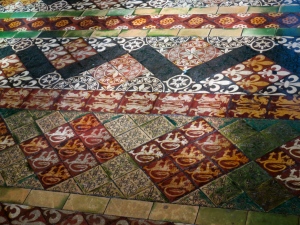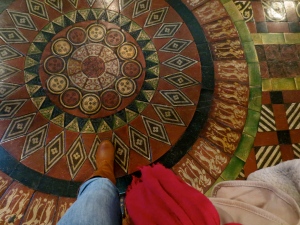Saturday night, Amelle and I walked home from the tram station after a night at the pubs. The neighborhood—so cheery during the day—looked strange under the whining yellow street lights, casting everything in shadowy mustard colors. Not sinister in the dark, the primary-colored doors still shone from their frames; the brick terraced houses still neat and warm looking, still with tidy gardens and vine-covered wrought iron. Not sinister, or gloomy, but strange, like a bright café festooned for Halloween, the pale blue walls hung with cobwebs and paper bats, the floral mugs sitting on black tablecloths—incongruous. I found nighttime and streetlight illumination incongruous with Rathmines.
“What do you do tomorrow?” Amelle asked, her heeled boots clicking against the sidewalk.
“I promised a friend I would go to church,” I said.
“Well, there are very many churches in Dublin.”
“Yes, I have lots of options,” I said, but I my thoughts strayed towards Christ’s Church—and wasn’t I annoyed that this church and its great sister, St. Patrick’s Cathedral, were Anglican?—the churches that weren’t options, well, options for experiment, but not for my chosen prayers. Churches like the one slowly growing in our view, a gray mass of stone angles. Somewhat distant from the last street lamp, it stayed dark, with its diamond-paned windows dully reflecting an ashes-and-honey mosaic—gray, black, gray, yellow—the maples and sycamores breathing softly in the yard. The old tombstones tall and tilted, like a partially destroyed house of cards. Holy Trinity Church, also Anglican, sat right at the end of my street, visible from my front door. It’s constant presence in my peripheral vision coaxing my annoyance towards something more complicated.
Well, there are very many churches in Dublin—Yes, I have lots of options—in some ways. My thoughts strayed farter, back to the cab driver from my first day—Lost a lot’a churches here’a late. B’cause d’at child abuse scandle’s so drawn out’ere . . . Yeah, lost a lot’a churches here—then I was thinking about Spain, about Seville. There, almost a year ago, I attended the Sunday morning Mass at the world’s largest Gothic cathedral, third biggest church on the planet. It’s size, the weight of the brown stone above, making me feel like I was underground, far underground staring up towards some unreachable opening, the pale stained glass windows high above. In the world of gloom-and-shadows stone, the blue and green in the windows became a better place of grass and rivers, of light. I was supposed to be gazing up to heaven, but I felt like I was descending into hell a la Dante, then looking over my shoulder, back up to Earth, wondering—What am I leaving?
“I hope people actually go to church here,” I told Amelle as we neared home, “when I was in Spain there were many beautiful churches but they were often very empty.” Mass in Seville’s cathedral on a warm July Sunday: only fifty people, most over sixty, the rest bumbling tourists who talked through the service, a rapid-fire homily, no music. Mass complete: forty minutes elapsed.
Amelle looked at me curiously, “Ireland is majority Catholic, no?”
“So is Spain, supposedly.” We walked on for a while, turning onto our street, narrower, the houses slightly shabbier, trash in some yards and flushed against the curbs. Paint peeling from the lintels and gables, from the green and red doors. Rust showing through on the railings. Overgrown ivy beside wilting daffodils.
“Do people go to church in France?” I asked, hoping to illustrate my point.
“Eh, no. No in France most people do not believe, they are—I do not know what is the word?” As we opened the purple gate to our driveway.
“Atheists?”
“Yes. Yes, most people in France are atheists and they do not go to church.”
I nodded, bid her goodnight, and slipped upstairs, hesitating a moment before setting my 7:00 alarm.
I didn’t get out of bed when it went off. Gray light seeping in under the heavy blinds that I kept drawn against the street lamp outside. I had planned to attend the eight-o-clock service—I generally prefer the early-bird bunch to the crowdedness of later services—but now eleven-o-clock was my only option. Listed as the “family Mass,” I prepared for screaming children, cooing parents and crowds.
But instead of getting up at 9:00, I laid in bed for another hour, feeling slightly morose and not really wanting to leave the accumulated warmth under my comforter. Eventually hunger overpowered laziness, and I crawled out to make pasta—my breakfast, lunch, and dinner. Down in the gray kitchen, absently stirring the pot and watching the clock. 10:20—and it was about a fifteen minute walk to the church. Finish cooking, eat, brush teeth, put on make-up, walk—sudden anxiety that I wouldn’t even make the eleven-o-clock, or worse, that I would make it late.
But apathy quickly smothered anxiety. If I didn’t make it to church, I didn’t make it to church. I’d go next week. For now I’d retreat to my comforter, watch a movie, talk a walk in the city this afternoon if weather permitted.
I left the house ten minutes later, not quite sure how I’d managed it, pleasantly surprised that I’d be to the church fifteen minutes early.
Mary Immaculate, Refuge of Sinners is just as grand as it sounds. I hesitantly approached the four huge pillars supporting a triangular façade, reminding me of old Greek ruins except for the stone angels staring down from the corners and the huge copper-dome-gone-green. Through the heavy wooden doors, I entered a space of blues and creams, incredibly ornate arched ceilings covered with robin-egg insets and cream-plaster medallions. Even on that overcast day, the sun through the windows reflected off all the pale surfaces until the whole space glowed—so different than Seville.
Rows and rows of dark wooden pews and red-fabric kneelers. I counted them, estimating this place could hold six hundred people. But at the moment, I was the only one. Three older women talked quietly at the back of the church, arranging weekly bulletins and exchanging gossip. One broke away to kneel in the back pew while I went halfway up the aisle to sit, feeling incredibly conspicuous, my heels clicking on the tile. I knelt and sighed. This was Ireland, not Spain. People might just come late.
And they did, all thirty of them scattered through the wide sanctuary. We looked like a congregation of xenophobes.
After a few more people filtered in, a rather round woman with short honey hair stepped up to the ambo—“Good morning, it’s great t’see so many people here”—I resisted the urge to glance around with raised eyebrows—“and we’d like to welcome the O’Connell family who are here f’r’a family reunion”—she gestured left to a block of about ten people sitting in their Sunday best. I was doing the math on how many people must usually come to this Mass, and coming up with about two. The woman continued—“T’is morning we’re going t’do somet’in’ a little bit different, we have t’hymns printed in the regular bulletin instead of printing an extra hymn sheet”—I flipped to the inside of my bulletin, opposite the readings from Acts, Revelations, and John, were three short hymns and a psalm. The woman sung the first verse of the hymns for us to learn—because there were no printed notes. “Now, the ot’r t’ing we’re doing different, is t’at we’re goin’ t’sing t’e psalm today, which is somt’in’ we don’t always do at t’is Mass. How it works is, I’ll sing t’refrain first, t’en you sing it wit’ me, here, let’s practice—‘O God, may all the nations praise You, let all the nations praise You’”—she raised her hand for us to join, I hit the first note and immediately killed the motor. No one else was singing, not unless breathing into your bulletin while moving your lips counted.
“Good,” said the cantor (and this time I did raise my eyebrows), “Let’s try’t once more.”
I gave my alto notes a little more reign, hoping people would be more confident if they felt like others were singing. Incorrect. I remained solitary. Loud, and solitary. The cantor made eye contact with me from the ambo.
After the singing lesson, Mass began. A slender bald priest taking his place to the left of the altar, “T’Lord be wit’ya.”
“And with your spirit,” I said, and started, surprised by the dominance of my own voice, wondering if I had said the wrong thing, if the responses in Ireland were different. In the states, everyone speaks together, each individual curving their natural cadence slightly, fitting into the larger voice until all the words come together, a thundering “And with your spirit.” Each church, each mass even, takes on a slightly different speed, rhythm, rising and falling pitch pattern. And if you grow up tin the same parish, at the same service for an entire childhood of Sundays, that pattern becomes as internal as DNA, as taken for granted as a native language, as recognizable as one’s own name. So when I spoke full and confident under the creamy domes of Mary Immaculate, Refuge of Sinners—And with your spirit—I was startled to speak alone. I recoiled immediately, assuming an error on my part. But when the next came, I listened and realized everyone was saying the same thing, but at different times, speeds, and rhythms, without regard for the voices around them. The church hummed slightly, but did no speak.
I felt the shadows of Seville closing around my shoulders. I hadn’t realized how much I was counting on these responses, on these words. I had come, expecting to find a place with it’s own strong cadence, it’s own pattern of prayer. I had expected to incorporate that pattern into my own, if only a little, through the ten Sundays I would spend here in Dublin. But instead of a voice, instead of a rhythm I could make my own, I found disintegration and separateness. I felt as if I’d knocked on the door of an adopted family, and instead of seeing them all waiting around the dinner table—T’Lord be wit’ ya’–And with your spirit—I found my adopted mother, father, brother, niece, uncle, all in different rooms doing different things. Paying no attention to one another or to me. The church seemed to darken.
The priest went on: “Now in t’first reading, we see a beautiful city comin’ down from heav’n”—I paused and checked my bulletin. He was talking about Revelations, the second reading. The first was about circumcision disputes in the early church, a reading from Acts. Maybe he just misspoke.
But when the lector came up to read—“T’e angel took me in spirit to a great, high mountain, and showed me t’holy city Jerusalem”—somewhere behind and to my left, a baby started screaming, cuing another, then another sitting five rows in front of me, her blond father bouncing her in his arms. Soon the lector was half shouting—“T’E CITY HAD NO NEED A’SUN’R MOON T’SHINE ON’T, FOR T’GLORY OF GOD GAVE’T LIGHT, AN’ ITS LAMP WAS T’LAMB!”
At least in one expectation for this morning, I had not been entirely incorrect: many screaming babies.
Mass continued. During the homily, the children came up around the altar, and the priest asked them to imagine their own city of Jerusalem—the general consensus was that it had a purple castle and lots of sheep. I don’t really remember the rest of what he said. The incorrigible green-eyed tot playing peek-a-boo with his parents from behind the alter, the sudden discovery that shouting meant the priest’s mic shot your voice around the room, and general cheery mischief distracted me. Or so my story goes.
At communion, the woman sitting to my left—the direction of the center aisle—made it very clear she was not going up to receive bread and wine. But, as she was elderly and rather round, she also made it clear she was not shifting from her seat. This caused only minor embarrassment for me, as I tottered along the kneeler in my gray-canvas heels, but the bent-and-gray grandfather behind me had more trouble, and his cloud-haired wife even more. Soon the no-communion-lady was shuffling into the aisle, huffing. The grandpa was grumbling, the wife advising, their daughter directing, their son-in-law hovering, the whole church staring. Lucky for me, once I cleared the bottleneck, a teal-eyed teenager with red hair and freckles waved me into the line, so—letting his courtesy be my excuse to ignore the difficulties behind—I entered the stream, quickly carried away from the pile-up, off to the dinner table.
The communion wafer tasted even more like nothing than the air-and-wheat cardboard served up at home, and while holding the chalice I briefly contemplated downing all the wine and making a break for it. I rolled my eyes at myself, to the confusion and distress of the woman proffering the cup, who did not understand the inward direction of the gesture.
Mass ended, to a chorus of babies ringing louder than the half-un-sung hymn. I left my pew, darting around the no-communion woman still teetering at the end of the bench, walked straight up the center aisle and out the double doors, back into Dublin, the city streets.




